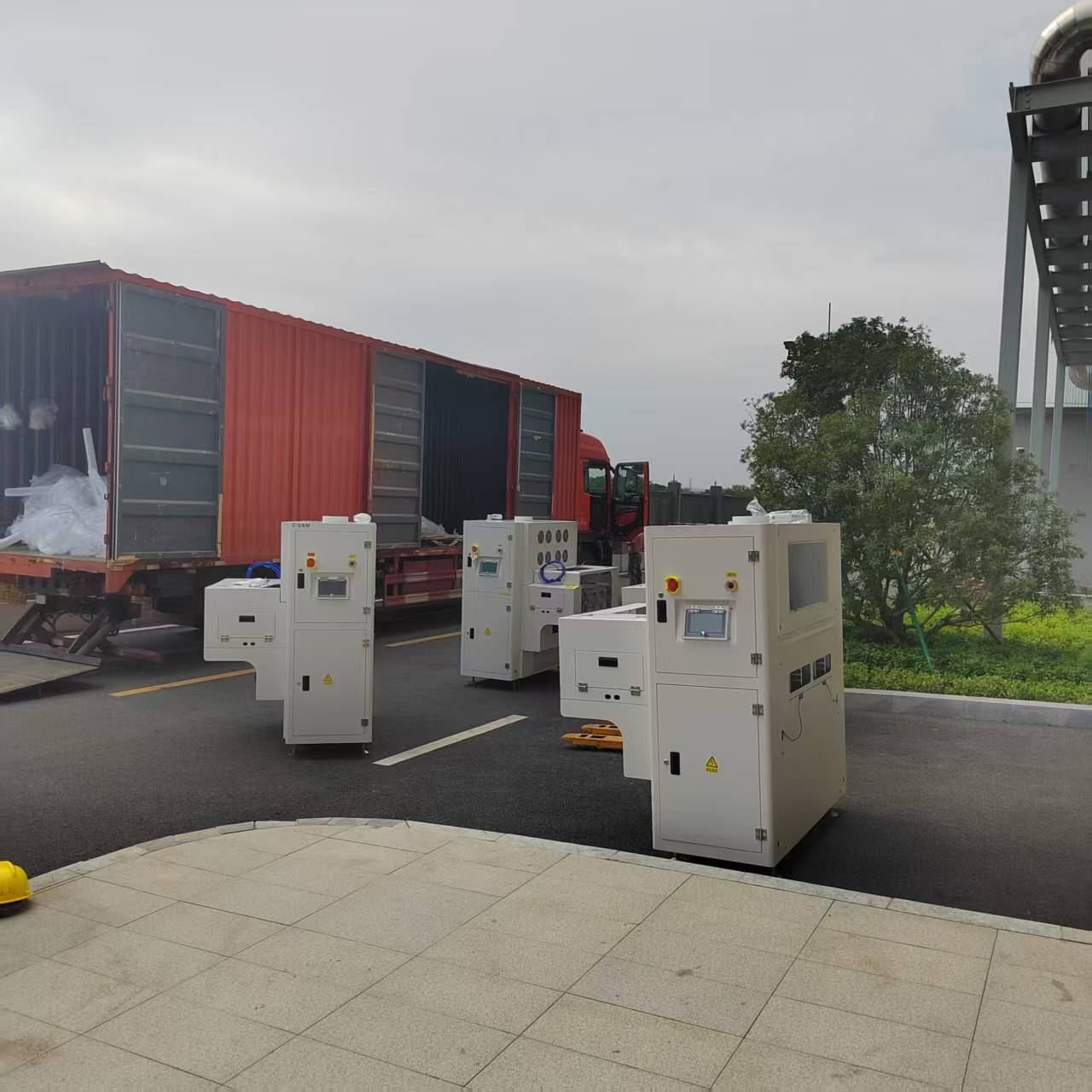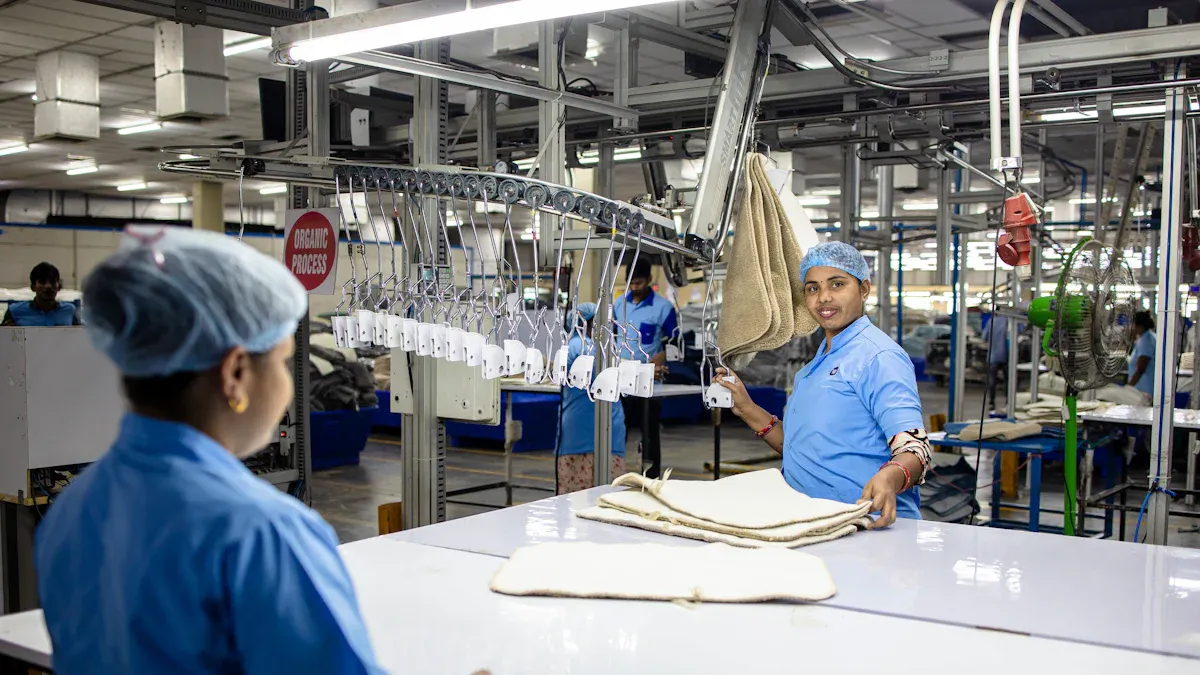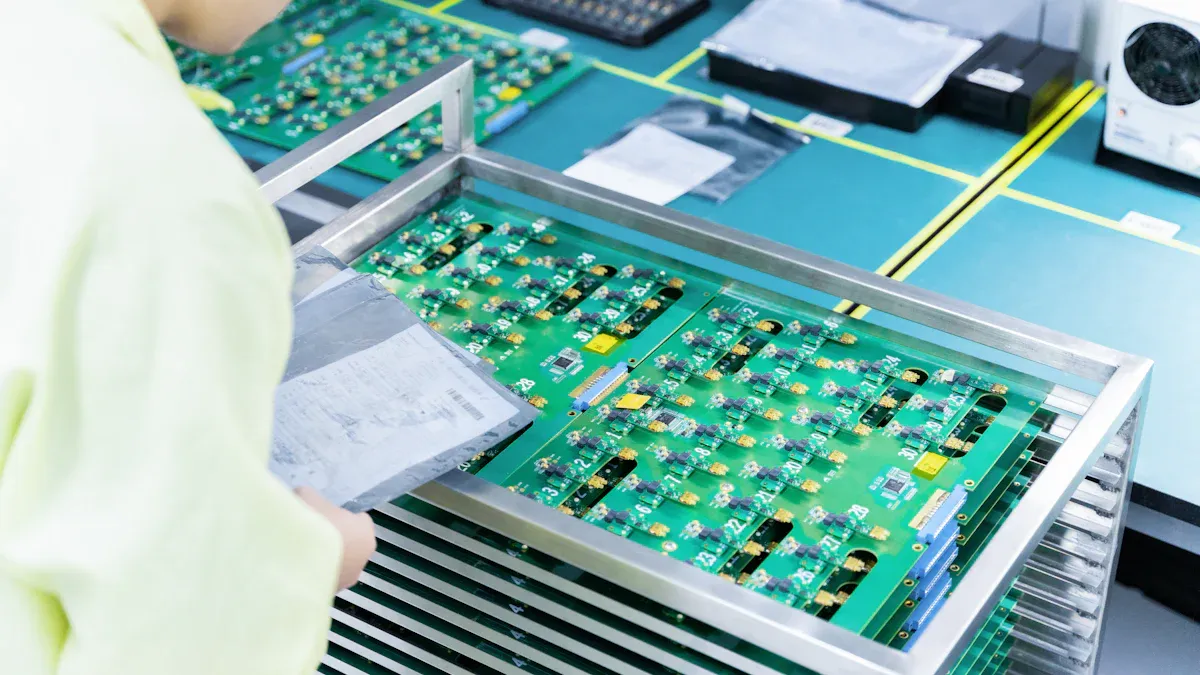
You can optimize your SMT manufacturing process by using an SMT Buffer to keep production running smoothly. Automated buffering systems help you avoid downtime and keep your assembly line moving. For example, automation allows continuous cycles and reduces manual adjustments, which means fewer interruptions. With thousands of SMT components placed per hour, your production time drops, and you reach the market faster.
The PCB Magazine Type Buffer machine supports a steady workflow, cutting downtime and boosting productivity.
|
Feature |
Benefit |
|---|---|
|
Lean material management eliminates 95% of material WIP |
Reduces cycle time by minimizing waiting times for materials |
|
Warehouse inventory can be reduced by 75% |
Lowers costs and enhances flexibility in production schedules |
Key Takeaways
-
Use SMT Buffers to minimize downtime. They store finished boards, allowing upstream machines to keep running even if downstream machines stop.
-
Integrate automated transfer systems to improve efficiency. Automation reduces errors and speeds up production by moving PCBs without manual handling.
-
Implement NG/OK PCB separation to quickly sort faulty boards. This keeps your production organized and reduces mistakes.
-
Place buffers strategically in your production line. Proper placement helps prevent jams and maintains a steady workflow.
-
Focus on critical tasks by reducing manual handling. This boosts operator productivity and creates a safer work environment.
SMT Buffer Efficiency

Minimizing Downtime
You can keep your production line moving by using an SMT Buffer. This system reduces machine stoppages and keeps printed circuit boards (PCBs) flowing from one stage to the next. When a machine downstream stops working, the buffer stores finished boards until the line is ready again. This means your upstream machines do not need to stop, so you avoid costly downtime.
Automated SMT board handling lets you process hundreds of boards per hour. You do not need to rely on manual transfers, which often slow down production and increase the risk of errors.
New conveyor and buffer systems also help you reduce manual handling. This lowers the chance of damaging or misaligning PCBs. You get a smoother, safer, and more reliable process.
Increasing Throughput
You can boost your output by integrating an SMT Buffer into your assembly line. Buffering systems keep a steady supply of boards ready for each machine. This helps you avoid gaps between production stages. When you maintain a consistent flow, you can reach higher throughput rates.
-
Buffering systems help maintain a consistent flow of materials, reducing downtime between production stages.
-
If a malfunction occurs downstream, the buffer allows the constraint machine to continue running, storing its output.
-
Properly sized buffers reduce the chance of shutdowns due to downstream malfunctions, thereby increasing overall throughput.
-
Buffering systems ensure a steady supply of components ready for processing, which is crucial for maintaining production flow.
Automated conveyor systems can keep up with complex assembly tasks. Some systems can handle up to 500 boards per hour. This level of efficiency means you can meet tight deadlines and handle larger orders without sacrificing quality.
Streamlining PCB Flow
You can streamline your PCB flow by using automated SMT Buffer solutions. These systems move boards smoothly from one process to the next. Automation reduces the need for manual intervention, which helps you avoid mistakes and keeps your line running at peak performance.
An automotive parts supplier improved their process by using translating suction machines. These machines picked up PCBs automatically and placed them with uniform grips. Workers could then focus on more complex tasks, which lowered costs and improved product reliability.
-
Automation allows PCBs to move seamlessly through the production line, enhancing efficiency and consistency.
-
The system prevents production bottlenecks by ensuring proper queuing of PCBs, leading to higher throughput.
-
Optimized conveyor systems can maintain a consistent output, even during complex assembly processes.
You can also scale your production easily. Automated systems adjust to handle more boards as your business grows. This flexibility helps you stay competitive in a fast-changing market.
PCB Handling

Automated Transfer
You can improve your SMT line by using automated transfer systems. These systems move PCBs from one machine to another without manual handling. Automation increases efficiency and accuracy. You get faster production and fewer mistakes.
|
Benefit |
Description |
|---|---|
|
Automating the component transfer process significantly enhances production efficiency, leading to higher output and shorter lead times. |
|
|
Improved Accuracy |
Automated systems reduce human error, ensuring components are accurately tracked and used, which enhances product quality. |
|
Cost Savings |
Reduces labor costs and minimizes component damage during transfer, leading to lower overall production costs. |
Automated handling also brings flexibility. You can adjust settings for different PCB sizes. A user-friendly interface makes it easy to integrate into your workflow. Consistent operation ensures every board receives the same careful treatment.
NG/OK PCB Separation
You can sort PCBs quickly by using NG/OK separation in your SMT buffer. This feature separates faulty (NG) boards from good (OK) boards as soon as they leave the assembly line. You avoid errors and keep your process organized.
|
Feature |
Benefit |
|---|---|
|
Dedicated slots for NG and OK PCBs |
Quick and easy sorting, reducing errors |
|
User-friendly interface |
Easy to learn and operate, minimizing training time |
|
LED status indicators |
Clear tracking of PCB status, enhancing workflow |
|
Prevents manual inspection |
Frees up workers for other tasks, improving overall productivity |
|
Minimizes downtime |
Increases throughput, ensuring smooth production flow |
-
The buffer allows immediate sorting, which keeps faulty boards out of the next stage.
-
You maintain a clear distinction between NG and OK boards, reducing mistakes.
-
Sorting at this stage minimizes production delays and boosts efficiency.
Temporary Storage
You can manage production surges or delays by using temporary storage in your SMT buffer. This feature stores PCBs when one machine supplies boards faster than the next can process them.
Alfred Pammer explains that flat assemblies must be stored between processes, which creates additional manual work, wastes production space, and leads to tedious searches. Temporary storage in SMT buffers solves these problems by automating storage and retrieval.
|
Functionality |
Description |
|---|---|
|
Smart systems store and manage materials, making them available when needed. |
|
|
Space Efficiency |
Compact designs save valuable production space. |
|
Traceability |
Automated documentation helps you track every board for quality assurance. |
Temporary storage keeps your workflow balanced. You avoid bottlenecks and maintain a steady pace, even during unexpected changes in production speed.
Bottleneck Prevention
Continuous Production Flow
You want your SMT line to run without stops. When you use an SMT Buffer, you keep boards moving even if one machine slows down or stops. This steady movement helps you avoid idle time and keeps every part of your line busy. If a machine needs maintenance or adjustment, the buffer holds the boards until the line is ready again. You do not lose time waiting for one process to catch up.
A well-managed buffer system can lead to big gains in production efficiency. When you address bottlenecks early, you help your whole line work better.
Buffer Placement
Where you place your buffers matters. You can put an SMT Buffer before inspection machines like AOI or after reflow ovens. This strategy helps you prevent jams and keeps your boards moving smoothly. If you work with different board types or change your production scale, you need flexible buffer locations.
-
Placing buffers at key points supports higher throughput.
-
You can handle multi-use and multi-scale manufacturing more easily.
-
Good buffer placement reduces the risk of bottlenecks and keeps your workflow steady.
Many manufacturers find that smart buffer placement saves space and lowers costs. When you store boards efficiently, you use less floor space and keep your facility organized.
Flexible Scheduling
You can adjust your production schedule when you have buffers in place. If one process runs faster than another, the buffer stores extra boards until the next step is ready. This flexibility lets you handle rush orders or sudden changes without stopping the whole line.
-
You can reduce manufacturing costs by keeping your processes balanced.
-
Efficient buffer management means you spend less time searching for materials and more time building quality products.
When you use buffers wisely, you support a smooth, reliable, and cost-effective SMT production cycle.
Quality & Reliability
Reducing Errors
You can reduce errors in your assembly line by using advanced buffer systems. Automated buffers help you avoid mistakes that often happen with manual handling. When you rely on machines to move and store PCBs, you lower the risk of misplacement or incorrect orientation. This leads to fewer defects and less rework.
Tip: Automated buffers track each board’s position and status, so you always know where your products are in the process.
A well-managed buffer system also helps you catch problems early. If a board fails inspection, the buffer can separate it from the rest. This keeps faulty boards out of the next stage and protects your final product quality.
Protecting PCBs
You protect your PCBs from damage when you use automated handling. Manual transfers can cause scratches, bending, or static discharge. Automated buffers use gentle conveyors and soft grips to move boards safely.
-
You avoid stacking boards, which can lead to surface damage.
-
You keep boards in controlled environments, reducing dust and moisture exposure.
-
You lower the risk of electrostatic discharge by using grounded equipment.
A buffer system gives each board the same careful treatment. This helps you deliver reliable products to your customers.
Process Consistency
You achieve process consistency by keeping your workflow steady. The SMT Buffer ensures that every board moves through the same steps at the same pace. This reduces variation and helps you meet strict quality standards.
|
Benefit |
Impact on Production |
|---|---|
|
Steady workflow |
Fewer process interruptions |
|
Uniform handling |
|
|
Automated tracking |
Better traceability |
Consistent processes lead to predictable results. You can trust your line to deliver high-quality boards every time.
Operator Productivity
Focus on Critical Tasks
You can boost productivity by letting operators focus on tasks that require skill and attention. When you use SMT buffers, you free your team from repetitive jobs like moving PCBs between machines. Operators can spend more time on quality checks, troubleshooting, and process improvements. This shift leads to better results and a more motivated workforce. You also reduce the risk of mistakes that happen when people rush through manual transfers.
Tip: When your team works on critical tasks, you see fewer errors and higher product quality.
Less Manual Handling
You lower the risk of injuries and mistakes when you reduce manual handling. Automatic handling systems take care of heavy lifting and awkward movements. Your operators do not need to bend or stretch in ways that can cause strain. Equipment such as palletisers and sack-filling machines can move heavy packages safely and efficiently.
-
Automatic handling systems eliminate the need for heavy lifting.
-
They minimize awkward bending and stretching movements that can strain the back.
-
Automation in manufacturing promotes a safer working environment.
-
Removing manual handling lowers the risk of injuries and errors.
You create a safer and more comfortable workplace. Your team can focus on tasks that add value, not on moving boards from one place to another.
Lean Manufacturing
You support lean manufacturing by optimizing your SMT buffer system. Lean principles help you match production to real demand, not just machine capacity. This approach lets you manage complex schedules and keep materials flowing smoothly. You avoid overproduction and reduce waste.
|
Key Practice |
Description |
|---|---|
|
Appropriate buffer sizes |
You must establish, maintain, and monitor buffer sizes for best results. |
|
Proximity of material buffers |
Keep buffers close to production for quick release of small batches. |
You improve flexibility and respond faster to changes in demand. By reducing buffer stock, you align your production with actual needs. This method helps you deliver products on time and keep costs low.
You can achieve higher efficiency, better quality, and smoother workflows by integrating advanced buffer systems into your production line. Recent advancements deliver faster assembly, greater reliability, and cost savings, as shown below:
|
Advantage |
Impact on Production Cycle Optimization |
|---|---|
|
Automates component placement, significantly speeding up production. |
|
|
Enhanced Reliability |
Reduces defect rates, ensuring consistent quality in production. |
|
Compact Product Design |
Allows for smaller, lightweight products, optimizing space usage. |
|
Cost Efficiency and Scalability |
Reduces labor costs and increases production line scalability. |
Many manufacturers now see up to 50% faster assembly times and defect rates below 100 ppm. As automation, AI, and sustainability shape the future, you can stay ahead by adopting strategic buffer integration for manufacturing excellence.
FAQ
What is an SMT buffer?
An SMT buffer is a machine that stores and moves printed circuit boards (PCBs) between steps in your assembly line. You use it to keep production flowing and prevent delays.
How does an SMT buffer improve efficiency?
You keep your machines running without stops. The buffer stores boards when one process slows down. You avoid waiting and increase your output.
Where should you place SMT buffers in your production line?
You place buffers before inspection machines or after reflow ovens. This helps you prevent jams and keeps your boards moving smoothly.
Can SMT buffers help reduce errors?
Yes. Automated buffers sort and track boards. You avoid mistakes from manual handling and keep faulty boards out of the next stage.
Do SMT buffers support different PCB sizes?
You adjust buffer settings for various board sizes. Many systems offer flexible trays and controls. You handle small and large PCBs with ease.
